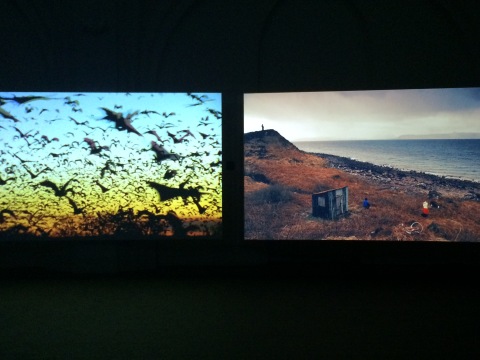Surrealism is a cultural movement which began in Europe in the early 1920s. The surrealists were inspired by Freud’s psychoanalysis and his work with the unconscious.
Karl Marx also inspired them: The liberation of the human being, as a basis for a classless society where everyone is equal.
Leader André Breton was explicit in his assertion that Surrealism was, above all, a revolutionary movement.
The question of the medium was in the very beginning debated by the Parisian surrealists; many had the opinion that painting didn’t have the potential of psychological depth or socially subversive, which was the movement’s primary focus. The art of painting was a consciously controlling intellectual construction without the ability to express life in modern reality. For the Surrealistic project, the preferred media therefore were collage, film, photo and object-art.
Wilhelm Freddie and surrealism:
Wilhelm Freddie’s art mostly builds on the idea of collage; even in his painting and sculpture.
The gap between the various element creates the tension; the viewer is searching for a connection and meaning.
The human being is the focal point in WF’s art; the human body is the base for all kind of examination and reflection of human existence.
Wilhelm Freddie about his working method:
“I exclude reason and logic and reproduces only the things that the spiritual eye sees in our subconscious.
I seek to find an expression of the mystery that hangs over the lives and the enigmatic and strange, hanging over our everyday environment.”
Breton’s method:
Bring you into a passive or receptive condition – release control – open the canal for mental movements appearance that instantly recorded in writing or image.
Wilhelm Freddie about his paintings:
They are like a renaissance in terms of color, and so, surrealism is new content.
Reflection:
To be honest; I never really liked Surrealism: The first thing that comes to my mind is the famous picture “La Persistencia de la Memoria” by Salvador Dali which I know only from poor reproductions. I don’t like his painting style; it makes me feel seek and uncomfortable.But I have realized that surrealism is much more than that; the thoughts and ideas behind surrealism are inspiring and interesting.
Wilhelm Freddie and Breton both talks about being impulsive in the creating process. That surprises me because I found the surrealistic paintings very constructed and detail oriented in contrast to expressionism which is more “here and now” regarding the material and the object. But as I understand; the surrealist work with “the before,” they had a dream or a sight, something occurred in the subconscious, and that is what they want to express in an immediate way.
The collage idea/strategy and the conscious clash of elements make for me a connection to the montage form in motion pictures which Eisenstein represent (one plus one gives three).
I like the idea of translating collage not only to be on paper but the idea of bringing various elements together – that is workable for any kind of media.
When I read about the surrealism movement’s interest in the darkness of humanity, the instincts, and sexual urges, it came to me that the filmmaker David Lynch is using the surrealistic language in his film. Dreams often used as a storytelling element in his film as well as subconscious meanings and sexual undertones.
Finally, I found that WF was a great colorist, he didn’t had that much focus (as Dali) on symbolic objects and he worked with a more simple and graphic expression.
Sources:
Wikipedia
Wilhelm Freddie, Stik Gaflen i Øjet/ Staten Museeum for Kunst
ISBN 978-9200-28-5

The Persistence Of Memory 1931 Salvador Dali

Legionaries pleasures 1936 Wilhelm Freddie

Sensual interior 1936 Wilhelm Freddie













